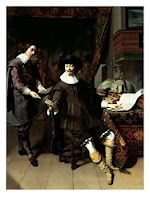
On February 23rd, 2007, Laura Marks discussed Islamic Art’s contribution to computer/digital arts. Braving the snowy weather, she opened the forum by outlining her research of Islamic Art on Western thought and paintings. She started with a quote from Paul Klee, declaring that “a line is a dream.” This line, compared to Islamic art, is abstract and infinite. Islamic art, or nomad art, through the Golden Age of the Arabic world (around 9th century to 1492) is abstract, multi-orientation and passes between points, contours, and lines. Usually displayed through flowers, vines or calligraphy reciting verses from the Qu’ran, she discussed how the lines were in a haptic space with no focal point, reflected in a non-orgainc/artifical light. Also, Islamic art represented the spiritual world of Islam. The symmetry of the art work, usually seen in Mosques, textiles, etc, showed that Allah (God) has no attributes, and that the world is infinite. The infinite world, created by God out of nothing, was not an innovation, but a skillful variation depicted through Islamic art work (trying to avoid the risk of being blasphemous).
As the Golden Age of the Arabic World transitioned into the Renaissance, Islamic art became a luxury for the bourgeoisie. In 17th century Dutch painting, as Marks highlighted, rugs would hang in the background, all details fine. The religious, oriental art, in a secular Western European world, would have conspicuous consumption and exotic appeal on the wealthy. Thomas Keyser, for example, in his Portrait of Constantijin Huyghens (1627) had a Persian rug hanging in the background. Blocking the door, the biblical rug, along with globe, indicates to the observer that the subjects are international travelers, bridging geography and intellect communicated through the detailed, Iranian/Caucasian flower forms on a red and black patterns. The floral arabesque is synaptic, connecting the brain to the clear and complex patterns.

As the 19th century welcomed the philosophies of transcendentalism and naturalism, Islamic art still captivated the elite of European society. Riegl (as Marks stated) stated that the abstract art forms a gradual development of lotus to arabesque-textile and ornaments, rejecting conformity to exhibit new form (will to art). Like a trail into the world, the patterns grow a leafy trail, which can symbolize the western chronological order of Europe. The tactile or haptic style can be linked to subjective, embody, unstable art to form a smooth and disentangle subjective perception. Also, Freud, in his office, draped his patient’s sofa with rugs from the orient. Since the oriental world, according to the 19th century, was viewed as primitive and tribal, the rugs tactile reality was hypnotizing, consciously smooth, and unravelling: an abstract wandering and unraveling patient.
Finally, in the dawn of the age of information and computer graphics, Islamic art is a reoccurring art form. In 1982, vector graphs, with abstract line in the middle leaving trail of light, were produced by analogs, which used real time with little data. Arcade games and 3-D animation eventually transitioned to computers, and the repetition of designs through symmetry and patterns show an independent existence, with any quantity having a mobile relationship, constant movement, and non-organic life. Computer art is able to draw out a tactile surface as programs, like MIGRATION, continues to grow without touching another line, preserve itself as long as possible.


